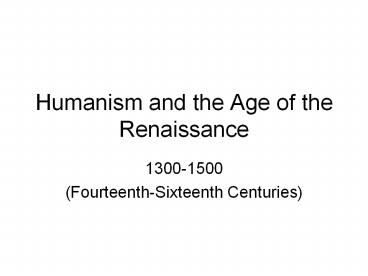Humanism and the Age of the Renaissance - PowerPoint PPT Presentation
Title:
Humanism and the Age of the Renaissance
Description:
Humanism and the Age of the Renaissance – PowerPoint PPT presentation
Number of Views:1397
Title: Humanism and the Age of the Renaissance
1
Humanism and the Age of the Renaissance
- 1300-1500
- (Fourteenth-Sixteenth Centuries)
2
- Humanism focuses on human experiences, values,
and interests it is a belief in humankind and
its inherent worth and dignity. - In essence, classical humanism refers to the
re-discovery of ancient classical Greco-Roman
texts (translated, studied, and preserved by both
Christian and Muslim scholars after the collapse
of Rome in 276 ACE) as well as art and
architecture. - In other words, classical humanism in the
Renaissance shifted from the strongly religious
focus of medieval times and focused instead on
human and secular concerns in the areas of
scientific inquiry, philosophy, medicine, art,
and literature, with a special emphasis on the
individual (individualism) and his or her
potential.
3
- For example, Giovanni Pico della Mirandola
(Pico--1463-1494) in his Oration on the Dignity
of Man writes that Who then will not look with
awe upon this our chameleon man, or who, at
least, will look with greater admiration on any
other being? . . . By reason of this very
mutability, this nature capable of transforming
itself, quite rightly said was symbolized by the
figure of Proteus (32). In this passage, we can
see how highly Pico values human potential to
change and transform, and we can also see how he
uses classical mythology in his reference to
Proteus, a sea god who was able to change his
form, just as Pico argues that man, the
chameleon, can also do. The idea that man can be
and is worthy to be at the center of all things
is evident throughout Picos text he even
suggests that the divine Creator longed for such
a creation as man. - Another example of classical humanism is Leonardo
Da Vincis famous pen and ink drawing called
Proportional Study of a Man in the Manner of
Vitruvius or Virtruvian Man. Vitruvius was a
famous ancient Roman architect, whose texts
inspired Da Vinci and his interest in seeing how
man and nature corresponded proportionally and
geometrically. Like a scientist, Da Vinci looked
closely at the natural world (plants, animals,
atmosphere), human anatomy, geometry. In other
words, he relied upon his close observation of
the world and knowledge from ancient classical
texts to inform his studies. In Vitruvian Man,
we can see how the male figure is the ideal of
proportion, fit into the circle and square
(geometry). Man is here, as the book notes, the
microcosm in the macrocosm (60).
4
(No Transcript)































